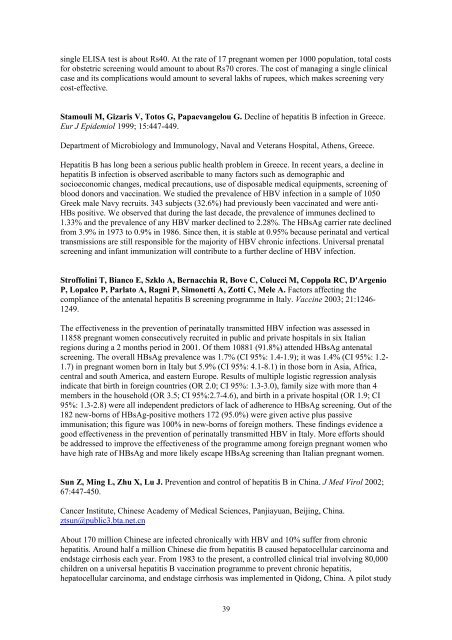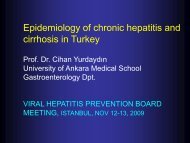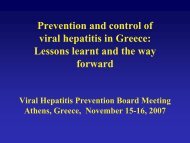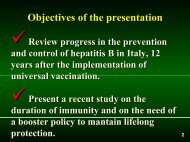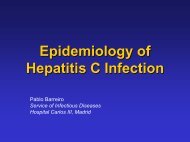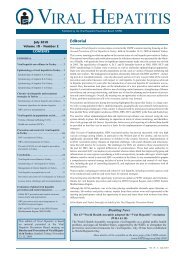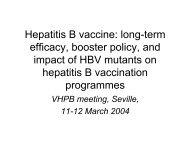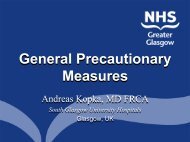pregnancy or early post partum; <strong>in</strong> 4 out <strong>of</strong> 16 HBeAg negative mothers by > 1 log dur<strong>in</strong>gpregnancy. Post partum ALT <strong>in</strong>creased <strong>in</strong> both HBeAg-positive <strong>and</strong> negative women. HBV DNAwas 10 9.4 -10 10.4 copies/ml <strong>in</strong> 3 HBeAg-positive mothers whose babies were, as compared to < 100-10 10.4 copies/ml <strong>in</strong> 18 whose babies were not, vertically <strong>in</strong>fected. Although the majority <strong>of</strong>HBeAg-negative women had low <strong>and</strong> relatively stable HBV DNA dur<strong>in</strong>g pregnancy, viremia wasalso relatively high <strong>in</strong> some HBeAg-negative mothers, <strong>and</strong> both viremia <strong>and</strong> ALT <strong>in</strong>creasedsignificantly late <strong>in</strong> pregnancy or shortly after delivery. Vertical <strong>transmission</strong> was only seen <strong>in</strong>HBeAg-positive mothers with very high levels <strong>of</strong> viremia. The value <strong>of</strong> measur<strong>in</strong>g HBV DNA <strong>in</strong>the pregnant woman to modify immunoprophylaxis to her <strong>in</strong>fant needs further study.Sood A, S<strong>in</strong>gh D, Mehta S, Midha V, Kumar R. Response to <strong>hepatitis</strong> B vacc<strong>in</strong>e <strong>in</strong> pretermbabies. Indian J Gastroenterol 2002; 21:52-54.Department <strong>of</strong> Medic<strong>in</strong>e, Dayan<strong>and</strong> Medical College <strong>and</strong> Hospital, Ludhiana, Punjab.A well-accepted vacc<strong>in</strong>ation schedule for preterm babies is not available. We therefore studied theresponse to <strong>hepatitis</strong> B vacc<strong>in</strong>e <strong>in</strong> preterm babies. Sixty babies born to HBsAg-negative motherswere studied. Group I (n = 20) consisted <strong>of</strong> term babies with birth weight > 2.5 kg, group II (n =20) <strong>in</strong>cluded preterm babies with birth weight between 1.8 <strong>and</strong> 2.49 kg, <strong>and</strong> group III (n = 20)<strong>in</strong>cluded preterm babies with birth weight between 1.2 <strong>and</strong> 1.79 kg. Mean gestational age <strong>in</strong> thethree groups was 38.5 (1.1), 33.5 (1.4) <strong>and</strong> 32.7 (2.1) weeks, respectively. All babies received 3doses (10 µg/0.5 ml) <strong>of</strong> a recomb<strong>in</strong>ant HBV vacc<strong>in</strong>e with<strong>in</strong> 3 days <strong>of</strong> birth, <strong>and</strong> at 6 weeks <strong>and</strong> 6months <strong>of</strong> life. Anti-HBs levels were measured one month after the 2nd <strong>and</strong> 3rd doses each; theimmune response was categorized as good responders (anti-HBs > 100 mIU/ml, low responders(anti-HBs 10-100 mIU/ml) <strong>and</strong> non-responders (anti-HBs < 10 mIU/ml). Good antibody responseafter the second dose was seen <strong>in</strong> 95% <strong>of</strong> babies <strong>in</strong> group I, 60% <strong>of</strong> those <strong>in</strong> group II <strong>and</strong> 10% <strong>of</strong>those <strong>in</strong> group III. This <strong>in</strong>creased to 100%, 90% <strong>and</strong> 45%, respectively after the third dose. Theresponse was <strong>in</strong>fluenced by gestational age (r = 0.73); 94% <strong>of</strong> babies with gestational age 34-36weeks atta<strong>in</strong>ed good antibody response compared to only 55% <strong>of</strong> babies with gestational age <strong>of</strong>31-33 weeks. Birth weight had no <strong>in</strong>dependent <strong>in</strong>fluence on the antibody response. The responseto <strong>hepatitis</strong> B vacc<strong>in</strong>e is <strong>in</strong>fluenced by gestational age. Hence, <strong>in</strong> preterm babies, it is advisable tocheck antibody titers one month after the third dose to assess the need for a booster dose.Sriprakash I, Anil TP. Rout<strong>in</strong>e prenatal screen<strong>in</strong>g <strong>of</strong> Indian women for HBsAg: benefits derivedversus cost. Trop Doc 1997; 27:176-177.Microbiology Department, MS Ramaiah Medical College, Bangalore, India.This study f<strong>in</strong>ds that pregnant mothers <strong>in</strong> India should receive prenatal screen<strong>in</strong>g for <strong>hepatitis</strong> B <strong>in</strong>order to prevent <strong>per<strong>in</strong>atal</strong> <strong>transmission</strong> <strong>and</strong> spread <strong>of</strong> the <strong>in</strong>fection with<strong>in</strong> the larger community.Neonates who contract <strong>hepatitis</strong> B will have an almost 90% risk <strong>of</strong> develop<strong>in</strong>g chronic <strong>hepatitis</strong> Bsurface antigen (HBsAg) carriage <strong>and</strong> chronic liver disease. Infants may spread the disease tosibl<strong>in</strong>gs <strong>and</strong> others. Neonatal immunization with HBIG <strong>and</strong> HBV vacc<strong>in</strong>e <strong>in</strong>terrupts vertical<strong>transmission</strong>. The US Centers for Disease Control recommend universal screen<strong>in</strong>g due to theaforementioned reasons. The study sample <strong>in</strong>cluded 520 third-trimester pregnant women whoattended a prenatal cl<strong>in</strong>ic at the Kempegowda Institute <strong>of</strong> Medical Sciences Hospital <strong>in</strong> Bangalore,India. Screen<strong>in</strong>g was conducted dur<strong>in</strong>g 1991-92. Serum samples were tested by ELISA us<strong>in</strong>gcommercial kits from Hoechst India. Positive samples were retested us<strong>in</strong>g Abbot's QUANTUM IIfor f<strong>in</strong>al confirmation. A full, detailed medical history <strong>of</strong> risk factors was collected for eachpatient. F<strong>in</strong>d<strong>in</strong>gs <strong>in</strong>dicate that 24 samples (4.6%) were positive. The positive cases <strong>in</strong>cluded 8 withblood transfusions, 6 with a bad obstetric history, 4 with experience as health care workers <strong>and</strong> noimmunization, <strong>and</strong> 6 with no risk factors. The hospital cases fit the pattern among the generalpopulation. In India, about 30-40% <strong>of</strong> pregnant HBsAg carriers are HbeAg positive. The cost <strong>of</strong> a38
s<strong>in</strong>gle ELISA test is about Rs40. At the rate <strong>of</strong> 17 pregnant women per 1000 population, total costsfor obstetric screen<strong>in</strong>g would amount to about Rs70 crores. The cost <strong>of</strong> manag<strong>in</strong>g a s<strong>in</strong>gle cl<strong>in</strong>icalcase <strong>and</strong> its complications would amount to several lakhs <strong>of</strong> rupees, which makes screen<strong>in</strong>g verycost-effective.Stamouli M, Gizaris V, Totos G, Papaevangelou G. Decl<strong>in</strong>e <strong>of</strong> <strong>hepatitis</strong> B <strong>in</strong>fection <strong>in</strong> Greece.Eur J Epidemiol 1999; 15:447-449.Department <strong>of</strong> Microbiology <strong>and</strong> Immunology, Naval <strong>and</strong> Veterans Hospital, Athens, Greece.Hepatitis B has long been a serious public health problem <strong>in</strong> Greece. In recent years, a decl<strong>in</strong>e <strong>in</strong><strong>hepatitis</strong> B <strong>in</strong>fection is observed ascribable to many factors such as demographic <strong>and</strong>socioeconomic changes, medical precautions, use <strong>of</strong> disposable medical equipments, screen<strong>in</strong>g <strong>of</strong>blood donors <strong>and</strong> vacc<strong>in</strong>ation. We studied the prevalence <strong>of</strong> HBV <strong>in</strong>fection <strong>in</strong> a sample <strong>of</strong> 1050Greek male Navy recruits. 343 subjects (32.6%) had previously been vacc<strong>in</strong>ated <strong>and</strong> were anti-HBs positive. We observed that dur<strong>in</strong>g the last decade, the prevalence <strong>of</strong> immunes decl<strong>in</strong>ed to1.33% <strong>and</strong> the prevalence <strong>of</strong> any HBV marker decl<strong>in</strong>ed to 2.28%. The HBsAg carrier rate decl<strong>in</strong>edfrom 3.9% <strong>in</strong> 1973 to 0.9% <strong>in</strong> 1986. S<strong>in</strong>ce then, it is stable at 0.95% because <strong>per<strong>in</strong>atal</strong> <strong>and</strong> vertical<strong>transmission</strong>s are still responsible for the majority <strong>of</strong> HBV chronic <strong>in</strong>fections. Universal prenatalscreen<strong>in</strong>g <strong>and</strong> <strong>in</strong>fant immunization will contribute to a further decl<strong>in</strong>e <strong>of</strong> HBV <strong>in</strong>fection.Str<strong>of</strong>fol<strong>in</strong>i T, Bianco E, Szklo A, Bernacchia R, Bove C, Colucci M, Coppola RC, D'ArgenioP, Lopalco P, Parlato A, Ragni P, Simonetti A, Zotti C, Mele A. Factors affect<strong>in</strong>g thecompliance <strong>of</strong> the antenatal <strong>hepatitis</strong> B screen<strong>in</strong>g programme <strong>in</strong> Italy. Vacc<strong>in</strong>e 2003; 21:1246-1249.The effectiveness <strong>in</strong> the prevention <strong>of</strong> <strong>per<strong>in</strong>atal</strong>ly transmitted HBV <strong>in</strong>fection was assessed <strong>in</strong>11858 pregnant women consecutively recruited <strong>in</strong> public <strong>and</strong> private hospitals <strong>in</strong> six Italianregions dur<strong>in</strong>g a 2 months period <strong>in</strong> 2001. Of them 10881 (91.8%) attended HBsAg antenatalscreen<strong>in</strong>g. The overall HBsAg prevalence was 1.7% (CI 95%: 1.4-1.9); it was 1.4% (CI 95%: 1.2-1.7) <strong>in</strong> pregnant women born <strong>in</strong> Italy but 5.9% (CI 95%: 4.1-8.1) <strong>in</strong> those born <strong>in</strong> Asia, Africa,central <strong>and</strong> south America, <strong>and</strong> eastern Europe. Results <strong>of</strong> multiple logistic regression analysis<strong>in</strong>dicate that birth <strong>in</strong> foreign countries (OR 2.0; CI 95%: 1.3-3.0), family size with more than 4members <strong>in</strong> the household (OR 3.5; CI 95%:2.7-4.6), <strong>and</strong> birth <strong>in</strong> a private hospital (OR 1.9; CI95%: 1.3-2.8) were all <strong>in</strong>dependent predictors <strong>of</strong> lack <strong>of</strong> adherence to HBsAg screen<strong>in</strong>g. Out <strong>of</strong> the182 new-borns <strong>of</strong> HBsAg-positive mothers 172 (95.0%) were given active plus passiveimmunisation; this figure was 100% <strong>in</strong> new-borns <strong>of</strong> foreign mothers. These f<strong>in</strong>d<strong>in</strong>gs evidence agood effectiveness <strong>in</strong> the prevention <strong>of</strong> <strong>per<strong>in</strong>atal</strong>ly transmitted HBV <strong>in</strong> Italy. More efforts shouldbe addressed to improve the effectiveness <strong>of</strong> the programme among foreign pregnant women whohave high rate <strong>of</strong> HBsAg <strong>and</strong> more likely escape HBsAg screen<strong>in</strong>g than Italian pregnant women.Sun Z, M<strong>in</strong>g L, Zhu X, Lu J. <strong>Prevention</strong> <strong>and</strong> <strong>control</strong> <strong>of</strong> <strong>hepatitis</strong> B <strong>in</strong> Ch<strong>in</strong>a. J Med Virol 2002;67:447-450.Cancer Institute, Ch<strong>in</strong>ese Academy <strong>of</strong> Medical Sciences, Panjiayuan, Beij<strong>in</strong>g, Ch<strong>in</strong>a.ztsun@public3.bta.net.cnAbout 170 million Ch<strong>in</strong>ese are <strong>in</strong>fected chronically with HBV <strong>and</strong> 10% suffer from chronic<strong>hepatitis</strong>. Around half a million Ch<strong>in</strong>ese die from <strong>hepatitis</strong> B caused hepatocellular carc<strong>in</strong>oma <strong>and</strong>endstage cirrhosis each year. From 1983 to the present, a <strong>control</strong>led cl<strong>in</strong>ical trial <strong>in</strong>volv<strong>in</strong>g 80,000children on a universal <strong>hepatitis</strong> B vacc<strong>in</strong>ation programme to prevent chronic <strong>hepatitis</strong>,hepatocellular carc<strong>in</strong>oma, <strong>and</strong> endstage cirrhosis was implemented <strong>in</strong> Qidong, Ch<strong>in</strong>a. A pilot study39
- Page 1 and 2: Pre-meeting documentPrevention and
- Page 3 and 4: Part I Prevention and control of pe
- Page 5 and 6: prevalence was significantly higher
- Page 7 and 8: clusters (obstetrics wards/hospital
- Page 9 and 10: Boxall E. Screening of pregnant wom
- Page 11 and 12: Chang MH, Hsu HY, Huang LM, Lee PI,
- Page 13 and 14: of infection in infants and childre
- Page 15 and 16: Eriksen EM, Perlman JA, Miller A, M
- Page 17 and 18: liver enzyme abnormalities than wer
- Page 19 and 20: health care, is feasible and achiev
- Page 21 and 22: HBsAg and anti-HBs in 4.5%. In the
- Page 23 and 24: immunoprophylaxis. Reflecting effec
- Page 25 and 26: Levin CE, Nelson CM, Widjaya A, Mon
- Page 27 and 28: Delaying vaccination of premature i
- Page 29 and 30: diagnosis. In the past, the inciden
- Page 31 and 32: shows that the prevalence of HBV in
- Page 33 and 34: Niu MT, Targonski PV, Stoll BJ, Alb
- Page 35 and 36: Ranger-Rogez S, Alain S, Denis F. H
- Page 37: vaccinees) and low reactogenicity o
- Page 41 and 42: newborns with surface antigenemia,
- Page 43 and 44: Wang Z, Zhang J, Yang H, Li X, Wen
- Page 45 and 46: of hepatitis B vaccine. This study
- Page 47 and 48: transmission has been estimated at
- Page 49 and 50: at birth and 2 weeks after birth, f
- Page 51 and 52: Chubinishvili OV, Mikhailov MI, Sak
- Page 53 and 54: Jensen L, Heilmann C, Smith E, Want
- Page 55 and 56: Onishchenko GG. Incidence of infect
- Page 57: Zanetti A, Tanzi E, Semprini AE. He


